Zime started graffiti 25 years ago. His labyrinth style pieces have been a major influence to many writers. He has also been one of the main actor of the sticker craze that popped up in the late 90’s in Europe.
Reasons enough to do an interview with Zime from SOL crew and talk about graffiti, his friends, Eindhoven, Iron Maiden & Philips Videopac.
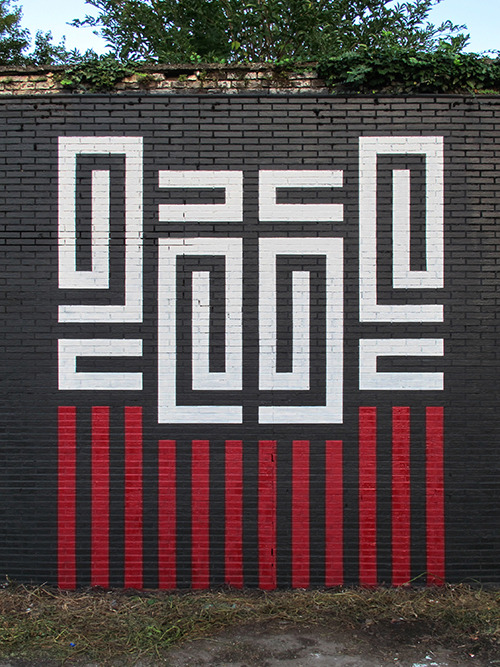
Can you present yourself?
My artist name is Zime. Born in the mid 70’s in Eindhoven, a city in the south of the Netherlands, and I still live there.

How did it all begin? What initially brought you to graffiti?
Before I got into graffiti I was already drawing a lot as a kid. My first graffiti memory I have is from the early/mid 80’s. I was drawing at my grandmother together with my nephew. He’s a few years older and is really into punk music. I remember he grabbed a marker and instead of drawing on the paper he wrote some names in punk style on a wooden box. As I was very young I didn’t really understand what he was writing but I knew I liked it! Every time I was at my grandmother’s I saw his tags on the box and I remember I copied some on paper. In the mid 80’s we had an Anti Vandalism project at our school. They showed photo’s of vandalism and some of them were photos of the first graffiti pieces in Eindhoven. I think this was the first time I saw a piece. It made a lot of impact on me. Amazing stuff done by early Eindhoven writers like Ace, Dusty, Freaky, Josh, Magic Mike (RIP), Skip, Spike, Mad (RIP), York and Yaki. From that point my school friends and I started drawing graffiti letters on paper and we did some pieces with chalk on the playground, but nothing serious. I did my first ‘real tags’ in the streets in 1988. I used the ‘A’ from Iron Maiden’s logo in my first tags. If I look back at my early tags now I can see the punk influence from my nephew. Also funny to see I was already using the symmetry in my letters.

Bombkid, Erosie, Late, Sektie and Zime (all SOL) and Sonik, Eindhoven 2001.
When did you get down with SOL crew? Who are the SOL crew members? (past and present)
I founded the Signs Of Life crew in 1990. First members were: Cray,Mause, Men, Rave and Wease. Sektie joined the crew a few months later and Erosie in 1993 when I saw him painting his first piece at our school. All members (except Men) were at the same high school in Eindhoven. The early members lost interest quite soon and in 1993 it was basically Erosie, Sektie and I. The 3 of us were in the same art class and we did some nice walls together in Eindhoven. Bombkid joined the crew in the mid 90’s and some years later Late. Some other SOL members: Ancle, Ane, Butch, Dres, Real and Sker. We’re mostly known for the Blind wall we painted in the centre of Eindhoven in 2001. This wall got a lot of attention in street art magazines and books. It was painted entirely with latex, paint and rollers. Back then we did sticker clusters with our names and symbols on it and this was the next step: painting our logo’s as a big cluster. From 1998 we started to use symbols. Erosie a Target, Bombkid a Bomb, Late a Clock with 2L8 in it, Sektie a Catgirl and I did the Skull.
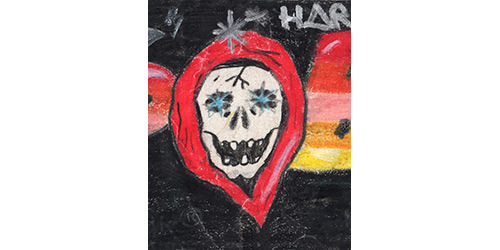
Skull sketch 1989

Zime skull carpet at the Dutch Design Week, Eindhoven 2004.

Zime, Skull, Eindhoven 2001
Why a skull as a symbol?
As a kid I was already drawing skulls and in my early graffiti sketches you can see it as well. I was influenced by the art work of Derek Riggs for Iron Maiden (he created Eddie, the band mascot) and also by Vernon Courtland Johnson who designed the skull of Powell Peralta. I was not into skating but some of my school friends were in the late 80’s. We were tagging the ramp and street while they were skating. But why skulls? The death of some close people in my early youth must be the reason I was drawing skulls and why I was fascinated with skulls from some artists at such a young age. I don’t see the skull itself as a negative thing. It’s part of (my) life. In a way the skull represents my labyrinth style. I see my letters as a skeleton, there’s no decoration or flesh on it.
I do also like the idea the skull always remains. Lately I’m making photo’s from my old stuff in my hometown, tags, pieces, stickers etc. This brings back so many good memories. I even found some old tags from the late 80’s; great to see there are still some around. It’s also nice to see an old (paper) sticker in a city where I haven’t been for years. A nice thought, gone but still there after so many years.


SOL designs from the mid 90’s
Do you remember where your “Labyrinth style” comes from?
An important moment was going to a Graphic School in 1993. I learned to work with the computer and my favourite program was Adobe Illustrator. To learn this program properly we had to copy logo’s, which was quite boring, so I started to design SOL logo’s during class. I made some prints of it and put them up inside school and I did some silk screens on a shirt as well.
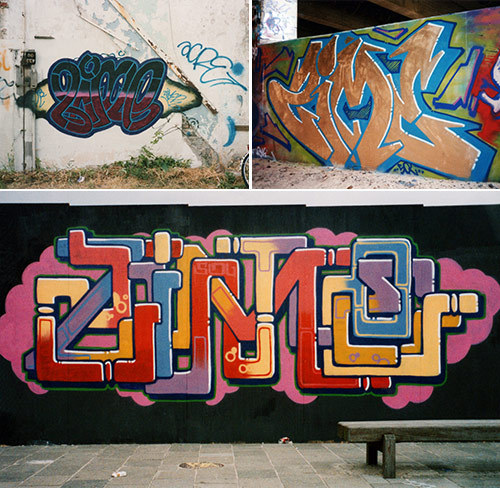
Style transformation: Zime Eindhoven 1994, Zime Berlin 1996 and Zime Eindhoven 1998.
At the same time my pieces became more basic/graphic during the years. Around 1995/96 I started to use less colours, no camouflage, just letters. The letters started to transform more and more. At a certain point my letters were built of only horizontals, verticals and diagonals. The next step was just horizontals and verticals with a thin outline. Then I did a sketch with the outline the same width as my letters and this labyrinth style was born.
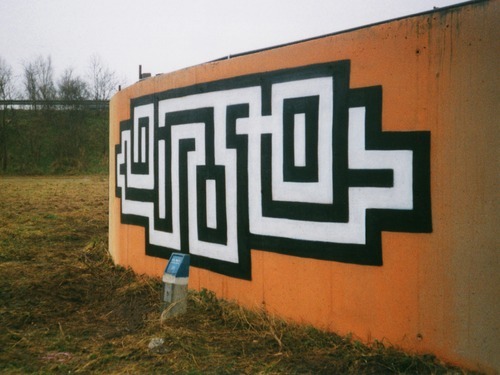
Zime, Eindhoven 1998
When did you paint your first “Labyrinth style” Zime?
In 1998. A black and white spray painted Zime on a terra cotta colour latex painted background. From the first moment I painted this piece it just felt right. The style just suits me. The first labyrinths were painted free hand with spray cans. A little later I started to use latex paint and rollers.

Influenza and a SOL sticker from 1999 in Eindhoven. Still there in 2013.
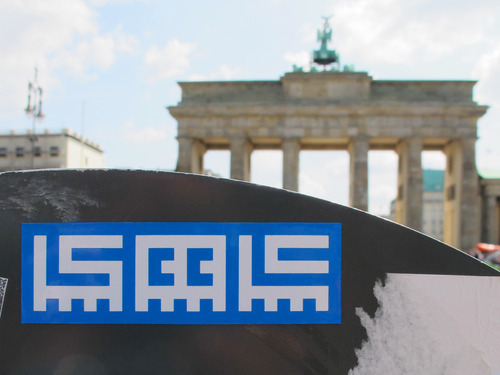
SOL sticker, Berlin 2013.
Did you have an interest in labyrinths before 1998?
Yes, if I think back now I was interested in labyrinths before. I have this memory from the early 80’s. I was drawing as a kid at my grandfather’s and I was creating my own labyrinths on paper. I don’t know why, maybe I was just bored, but I’m happy I have this memory.
Around the same time I got my first home video game system, a Philips Videopac G7000. The covers of these cartridge games have very nice detailed illustrations. When you start the game the nice detailed cowboy on the cover was built of only a few pixels high on your television. But I wasn’t disappointed. I really like these pixel characters. Very powerful! My favourite Philips Videopac game was Munchkin, a game based on 1980 arcade game Pac-Man. Munchkin was available in 1981, one year earlier than Pac-Man on a home computer. This frustrated Atari a lot, so they sued Philips. But Munchkin wasn’t a direct clone. In fact it was much better then Atari’s Pac-Man. The dots you have to eat were moving, the labyrinths were changing and could become invisible but the best thing was you could create your own labyrinths! I was playing this game for hours, everyday. To honour Munchkin I created a SOL sticker with a Muncher (ghost) as a O in 1999.
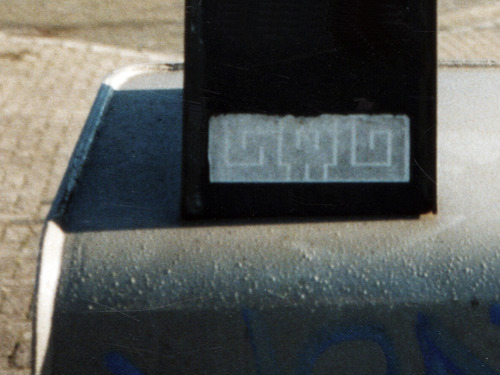
First SOL sticker, Eindhoven 1998.
The sticker scene was huge in Eindhoven since the late 90’s. Can you tell us a bit about this era?
Before this time you could see some tags on stickers, I did some as well, but nothing serious. Phet15 did a funny kuNSt logo sticker in the mid 90’s, but this was more a single action. I think you could say the sticker scene in Eindhoven started around 1998. It was Space3, Erosie and I. Soon after my first labyrinth style piece I started to create more labyrinth designs on the computer. I had some some A4 sheets with paperstickers left from a school job and I printed my first stickers. It made more sense for me to do a sticker in the same style as my piece in stead of doing another ‘traditional tag’ in the streets which is not related with my style. The first sticker I designed was ’S skull L’ and I printed them on my inkjet printer at home. When I pasted them on the streets I found out that only the Epson black was water resistant. So that’s the reason I only did black and white stickers.
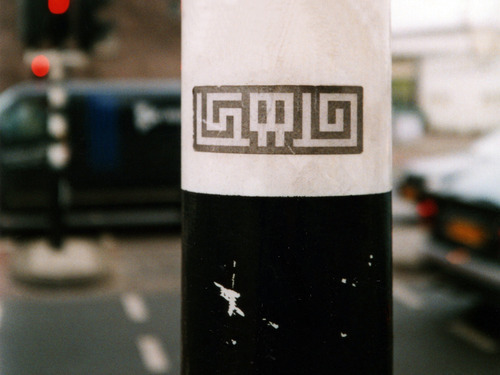
SOL sticker, Eindhoven 1999
The black ink faded in the years but it gave the sticker a nice touch. But at that time I didn’t like this fade so I started to put varnish on it. My room looked and smelt like a little sticker factory. There were A4 sheets with stickers everywhere as the varnish had to dry and I was in the middle of this sticker chaos creating and printing more stickers. I remember Erosie and I found a shop which sold boxes with 4000 Avery paper stickers a box for cheap prices. We bought all the boxes they had. A little later I met the 2 lads of Space3. It was the start of a big sticker explosion.
Sticker artists and things I remember from the late 90’s in Eindhoven: the targets of Erosie on his first stickers were done with a nice handmade stamp. The Evoluon/ufo based logo of Space3 was without the big round ears. A graffiti writer named ZXQL pasted little paper stickers with only his mysterious name printed on it… Rest In Peace mate.
The sticker scene was growing fast in Eindhoven after the Millennium. Some names: Betamaxxx, Bomb, Foxy Lady, Late, Schurk, Sektie and a little later Lempke. Also people from other cities came to Eindhoven to paste their stickers, like Influenza from Rotterdam, Toasters from Wolverhampton/London and Wood from Utrecht to name a few. The lamp posts in Eindhoven were pasted top to bottom and Eindhoven was known as ‘Sticker City’.
A very important thing for our (sticker) scene is that we really helped and supported each other. Space3 and I helped some guys to translate their symbols/ideas into a proper vector based logo. Space3 and Erosie did some great wallpaper designs with all the logo’s and as we were with quite a few sticker lads in Eindhoven we started to print our vinyl stickers together in one order at a sticker company in the city so we could get huge discounts. Lempke was always driving, it didn’t matter where in Europe, if someone did have an exhibiton we showed up with all the lads from Eindhoven. Good times!

Zime, Erosie, Dagu. Early 1999
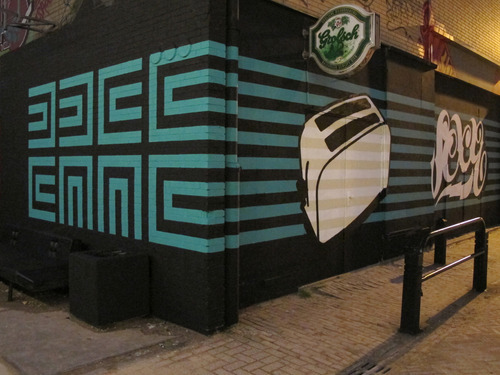
Zime, Toaster and Sektie. Area 51 Eindhoven 2012.
Do you enjoy painting with other artists?
Yes, most pieces I did I was with other artists, or better to describe them as friends. Mostly I paint with guys i’ve known for a very long time. It’s so much nicer to be with one or more people at a wall than just standing there on your own. I painted a lot of walls together with Erosie (one of the most talented guys I know) and even more with Sektie. I’ve paint with him since 1990. I really like his letters and characters. We do very different styles but somehow they combine very well.
Around 2006 I slowed down painting walls. Everyone from SOL got into different directions and our lives changed a lot. I lost the pleasure in painting walls. It took so much time and sometimes the wall was destroyed in a few days. I was only interested in pasting stickers. Together with Lempke, Eindhoven’s most fanatical street artist the last years, we pasted thousands of stickers.
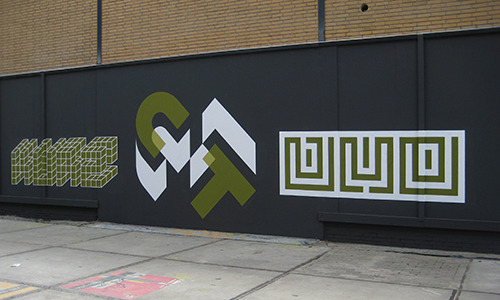
Kurz, CT and Zime, Eindhoven 2008.
I got an email from two young Italian lads in 2008. They were on a tour and wanted to do a wall with me. I checked their names at Ekosystem and I saw some amazing stuff. We did a nice wall in Eindhoven and their drive was unbelievable. It made me enthusiastic to paint again and it was the start of the Eindhoven-Torino connection. Thanks to CT and Kurz for that!
Another big inspiration is Toaster A, from Wolverhampton/London. He’s a really good friend. We’ve been doing stuff together for more than 10 years, at the beginning mostly stickers and posters. But from 2008 we started to do walls on a frequent base. Our graphic styles fit very well and we painted some really nice walls in Berlin, Birmingham , Eindhoven and London. Always a great time! Their image of the toaster became an icon, they are everywhere.
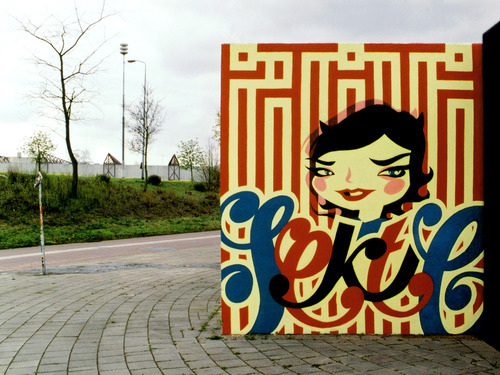
Zime and Sektie, Eindhoven 2003.
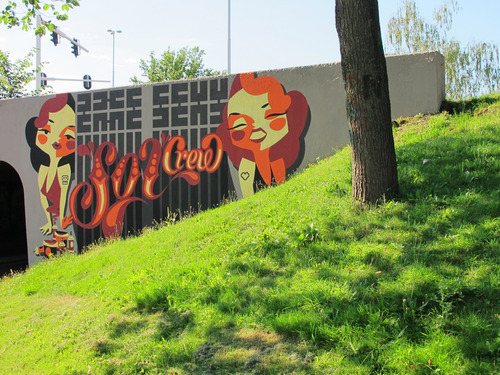
Zime and Sexy, Eindhoven 2013.
Which painting do you like most?
Difficult. With SOL crew I would say the Blind wall in the centre of Eindhoven. But personally… very difficult. I think one of my pieces with Sektie. But of course it’s not only the painting itself but also the relationship with the surroundings, the city where it’s painted and the story behind it. For example, painting in Mexico City was a great experience. I’d never seen so many police with huge guns on the streets as in Mexico City; it was unbelievable. Sometimes on every corner of every street, all for the war against drug gangs. It was a surreal setting. Neuzz from Mexico City showed me some nice areas and we painted some nice walls. I saw a lot of bright painted skulls and funny skeleton figures in Mexico City as they always celebrate Día de Muertos (Day of the Dead). So I decided to paint a big yellow skull. Unfortunately the yellow latex paint did not cover very well. It needed so many layers, even when I painted it white first. Luckily my girlfriend helped me to finish my piece in time. Her first and probably last piece :)
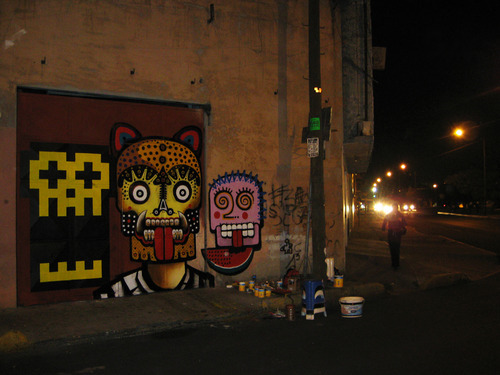
Mr. & Mrs. Zime and Neuzz, Mexico City 2009.
What does inspire you, and who’s work are you into? (Not necessary in the graffiti world.)
So many names… I already named some. To make it easier I will only mention my favourite dutch artists.
My main inspiration since the 80’s is Phet15 from Eindhoven. He had already developed an original geometric style in the late 80’s while most others were still painting a (sort of) New York style. He’s still doing great stuff and is a nice guy as well.
Other graffiti/street artists from Eindhoven; Deshamer (especially his Berlin period together with Ces53 from Rotterdam), Space3 (they are pasting great graphic posters since the mid 90’s, real pioneers) and of course my mates from SOL crew.
Other graffiti/street artists from the rest of the Netherlands: Delta, Graphic Surgery, Shoe and Zedz.
Dutch Art/Graphic Design: Piet Mondriaan and De Stijl movement, Hendrik Wijdeveld and his magazine Wendingen, Hendrik Werkman and his magazine The Next Call, Dick Bruna and his Zwarte Beertjes books, Joost Swarte and his clear line illustrations and Wim Crouwel and his grid-based layouts and typography.
Do you make a difference between street art and graffiti?
SOL crew started as a traditional graffiti crew but from 1998 we were transformed. Our styles changed and we started to use other tools (the computer, stickers, posters, latex paint, rollers, etc.). It was step by step but it was too quick for some. Some writers told us this wasn’t ‘real graffiti’ or wrote some stuff near our paintings. It didn’t bother me. I saw it as a compliment and a sign we were doing the right thing. Anyway we were street artists some years before the term street art was used. There was simply no name for it back in 1998-2002 and to be honest I liked this. Personal I like the name Street… but the label ‘street art’, I don’t know. I don’t have a problem with it, like some other artists have. Maybe the label ‘post graffiti’ is better to use? One of my favourite bands is Joy Division. Their music is labeled as ‘post punk’. You can see graffiti as punk, raw and dirty and ‘post graffiti’ as ‘post punk’, still intense but more refined.

Zime (SOL crew) and Toaster, Berlin 2012.
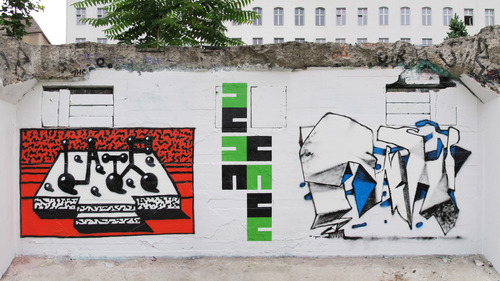
Late, Zime and Erosie, Berlin 2013.
How do you define your work?
My work is a mix of graffiti, graphic design and geometric abstract art. About the graffiti part: I still use my graffiti name. You can see my stickers as tags and my wall paintings as pieces. My paintings are not in a real labyrinth style anymore. A few years ago I started to construct my letters with U shapes. Now my 4 letters are chopped into 8 U shapes which form my name. It’s a bit like the game Tetris. I rotate the U shape in 90° until I get my letters.
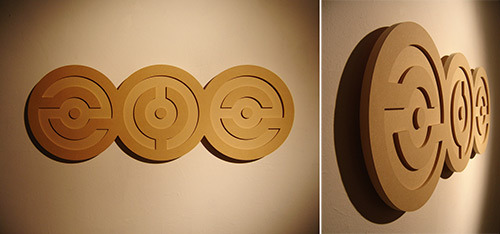
Zime at Punct, The Netherlands 2004.
Do you also do exhibitions?
Yes I did some group shows in Eindhoven, Helsingborg, London, Prague etc. mostly with close friends like Influenza, SOL, Space3 and Toasters. One of the best was Ill communication with SOL in Urbis, Manchester. We painted a very nice wall there, maybe even better then the Blind wall in Eindhoven. This time with fresher colors. Manchester is a great city with lots of nice industrial parts and a great music scene.
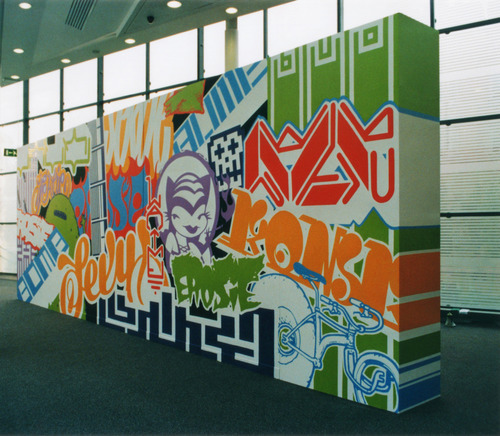
SOL crew: Bombkid, Erosie, Late, Sektie and Zime. Urbis, Manchester 2003.
If I visited Eindhoven, which are the places I shouldn’t miss?
Effenaar, lots of great bands played here, like Sex Pistols, Madness, The Cure and Joy Division.
Philips Stadium, from the beginning (100 years ago) PSV Eindhoven played their football matches at this ground. It’s situated in a nice working class area named Philips Dorp (Philips Village).
Evoluon, a UFO shaped building from Philips. It represents Eindhoven as a young and modern city.
Berenkuil, Hall of Fame since the mid 80’s. The pieces of Freaky by Phet15 and No Star Wars by Josh in Spraycan Art are painted here.
Area 51, an indoor skatepark at a former industrial area of Philips named Strijp-S.
Van Abbemuseum, MU and Dutch Design Week for art and design.
La Folie, the facade and toilets of this pub are covered in stickers. It’s the best pub in Eindhoven. Cheers!
Anything more you want to share?
Recently a true graffiti pioneer from Eindhoven died. He was writing since 1984 and was still active until this year. A very strong lad. Mad respect. At his fotolog page you can see a lot of his great pieces.
Rest In Peace Med TIV.
Any last words?
Love to P&E
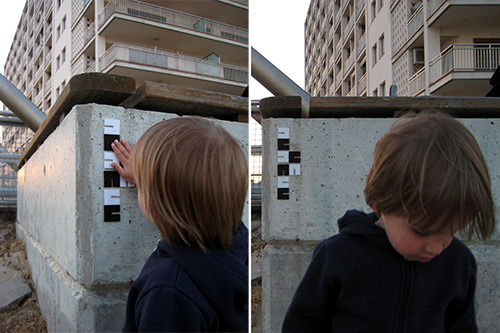
Zime, Catalonia Spain 2013.
—
Interview done in summer 2013
Zime on ekosystem photo gallery.
